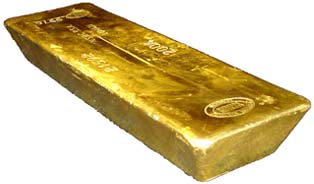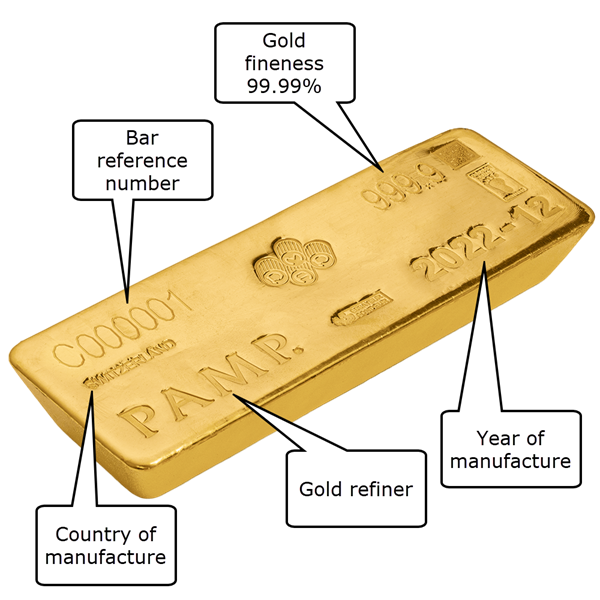Buying gold bullion is cheaper and easier than ever, while remaining the safest way to own and store gold. You can learn how to buy gold bullion online with BullionVault, or to discover a little more about what gold bullion is, please read on...
Gold bullion comes in two main forms: gold bullion bars and gold bullion coins. Gold has been a valuable material for millennia, and retains applications from the crafting of jewellery to the manufacture of electronics, but gold coins and gold bars have long had value in themselves as trading tokens and stores of wealth.
Gold bullion bars – the gold bars that you might see stacked up in Fort Knox or the Bank of England – derive their value entirely from their precious metal content.
Making sure your gold bullion is authentic

Investing in gold coins and small bars has never been easier. But whichever way you choose to buy, it’s not something that should ideally be stored at home. This is partly due to reasons of security, but also the value of gold bullion depends on the guarantee of authenticity.
The Good Delivery Standard of the London Bullion Market Association (LBMA), established in 1987, is important because it defines the weight, dimensions and composition of acceptable wholesale gold bars. This guarantee means that each gold bar is accurately assayed (measured for purity) at over 99.5% gold and can be traded on the professional bullion market.
Unlike gold bullion coins and small bars, Good Delivery bars have an unbroken chain of integrity, from the day they're first refined and manufactured they have never been stored outside of recognised professional bullion vaults.
Every time bars are moved - by accredited bullion couriers - a careful record is maintained, showing continuous storage through trusted hands. This guarantees gold bar integrity in a way that keeping gold at home, or even in safety deposit boxes, cannot match.
How gold bullion is made
Bullion’s etymology derives from Old French, whether ‘bouillon’ (cooking stock), ‘buillun’ (the cauldron where the stock was made) or ‘bille’ (a medieval ingot), and before that the Latin ‘bullire’ – to boil.

In Middle English, a ‘bullion’ was a melting house, a mint, or a place of exchange. Over time, the word became attached to the gold and silver bars exchanged in such places.
To make gold bullion, the precious metal is either mined from the earth or gathered from existing gold items. Mined gold needs to be refined, and gold ore that has been trapped within rocks is crushed first into gravel and then into fine powder.
Gold refineries then use heat and chemicals to dissolve and extract the gold from the powdered rocks. An extreme heating process (the ‘bouillon’) removes further impurities, leaving the gold ready to be poured into molds and cooled or rolled into strips called blanks to then stamped as gold coins or small gold bars.
An assayed sample is dipped from molten metal to ascertain the purity and define the pure gold fineness in order to meet the required standard and establish the value of each gold bar that is cast.
Why is gold bullion valuable?
Unlike jewellery, or numismatic coins, gold bullion's value is not artistic or practical. It is not there to be looked at and admired, but instead is stored for security or traded for profit.
Some may question why this particular metal has such a high value. The answer is complicated, and involves concepts of scarcity, history and beauty, but to fully understand the reasons that so many civilizations put such stock in gold bullion, we need to understand gold's monetary and trading role through history.
Ultimately, the value of gold and gold bullion rests on the continuation of a shared belief across different eras and civilizations that this precious metal is, in fact, precious, that it is scarce but not impossible to attain, and that it will not corrode or deteriorate in quality.
How the gold bullion trade works
It has never been easier for individuals to buy gold bullion coins or small bars at competitive prices. Whether buying gold bullion online or elsewhere, some routes are more secure and cost-efficient than others..
Gold bullion coins trade close to the world gold price, but you could still pay a premium of around 4% when you buy in quantity, and 8% when you purchase smaller amounts. You should expect to suffer a similar 4-8% discount when you sell gold bullion coins back to the dealers.
Gold bars come in many sizes. Bought from retail stores for private possession you will usually pay dealing costs similar to those for bullion coins.
Gold bullion bars can weigh anything from a few grams upwards. 1kg and 100 oz (~3kg) bars are sometimes - under strict controls and LBMA guidelines - accepted by participants in professional bullion markets in Zurich and New York.
But London is the world's main physical bullion marketplace, so the Zurich and New York bullion markets can attract higher price premiums when compared to low premiums offered in the UK capital.
London Good Delivery gold bars
In London, the market deals in the London Good Delivery gold bullion bar, effectively serving as “gold standard” gold. These gold bars are the bright, heavy, uniform blocks that most people think of as bullion.
The London Good Delivery bar is the most important bullion product in the world. Loco London (meaning the physical bullion bars will be passed from seller to buyer in London) is the de-facto standard for bullion spot trading all around the world.
This London Good Delivery bar of bullion weighs 400 troy ounces - about 12.4 kilograms - and is about eleven inches long. It is stamped on the top (the larger face) with the manufacturer's name, the weight, and the assayed purity.
This bullion is commodity gold, and stored in secure vaults. These gold bars don’t have the super-smooth finish you sometimes see in film or photographs of mock bullion. The moulded metal is so soft that the gold bars are frequently scratched on their faces and flattened on their edges and corners. The finish can also become slightly dented where the bars have been stacked up on top of one another.
Knowing the purity of gold bullion
All bullion delivered against a London spot market trade must be at least 99.5% pure and must also come in bars of a standard shape weighing about 400 troy ounces. They are also required to have been accurately assayed so that he exact gold content of the bar is guaranteed, with the weight and purity stamped on the gold bar.
In addition, each gold bar must have been manufactured by one of a listed group of refiners, and in almost all cases the bars are only accepted from one of a very small number of accredited bullion vaults or couriers.

How to access the best gold bullion prices
London Good Delivery bars are the cheapest form of gold bullion to deal and own, and it fetches the best prices when it is sold. But bullion in this form is not accessible to most private buyers.
While gold prices move all the time, it would only take a price of $12.50 per ounce – last seen in 2018 – for a gold bar to be worth $500,000. A second reason for the inaccessibility is that the profession market vaults where the bars must be kept do not deal with non-industry, public customers.
Fortunately, if you want to own bullion as an investment and access the best security and prices, you can invest in professional market London Good Delivery bullion through BullionVault.
If you need to know more about investing in bullion gold, you might like to continue your research by discovering the advantages and disadvantages of different ways of buying gold.
Gold bullion terminology
Assay
The process of measuring the purity of products containing gold. Bullion bars are stamped with their assay number guaranteeing purity
Karat
Gold bullion is 24-karat gold, measuring the highest level of purity. 24-karat gold is too soft to be used for jewellery, where gold is typically alloyed to silver or other metals to produce lower karat ratings
LBMA
London Bullion Market Association - international trade association representing the market for gold and silver bullion, which is centred in London but has a global client base
London Good Delivery
Rules issued by the LBMA governing the physical characteristics of gold and silver bars on the London wholesale bullion market
London Loco
Gold and silver bullion physically held in London vaults, underpinning the gold trading market
Troy ounce
A metric used for weighing precious metals. A typical gold bullion bar held by central banks is 400 troy ounces, which translates to 12.4kg or 439oz.






